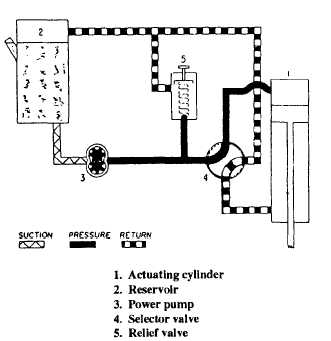indication of a contaminated filter. Some filters have a button to reset the switch after the filter has been serviced; however, on other filters, the switch resets automatically when the differential pressure is relieved.
If the filter is not properly serviced following the contamination indication and the equipment is kept in operation, the differential pressure continues to build. At 100 ÷ 10 psi, the bypass valve will open and allow the fluid to flow straight through, bypassing the filter element (view (B) of fig. 10-31). But on this filter the contamination indicator is to warn the operator that the filter element is clogged. The equipment can then be stopped before the bypass valve opens, thus preventing contaminated fluid from being passed through the hydraulic system.
HYDRAULIC SYSTEMS
In spite of the great variety of support equipment, all hydraulic systems-from the simplest to the most complex-operate according to the basic principles and make use of the components discussed thus far in this chapter.
As a CM1 you are responsible for analyzing the malfunctions of hydraulic equipment, ranging from the simple jack to large earth-moving equipment. Thus, the development, piece by piece, of a representative system should assist you in analyzing any hydraulic system.
REPRESENTATIVE HYDRAULIC SYSTEM
Basically, any system must contain the following units: PUMP, ACTUATOR, RESERVOIR, CONTROL VALVE, and TUBING. Figure 10-32 shows a simple system that uses only these essentials.
The flow of hydraulic fluid can be easily traced from the reservoir through the pump to the selector valve. With the selector valve in the position indicated by the solid lines, the flow of fluid created by the pump flows through the valve to the upper end of an actuating cylinder. Fluid pressure then forces the piston down, and at the same time, forces out the fluid on the lower side of the piston, up through the selector valve, and back to the reservoir.
When the selector valve is rotated 90 degrees, the fluid from the pump then flows to the lower side of the actuating cylinder, thus reversing the process. The movement of the piston can be stopped at any time simply by moving the selector valve to the neutral position (45-degree movement either way). In this position, all four ports are closed and pressure is trapped in both working lines.

Figure 10-32.-A simple hydraulic system.
The hydraulic system just described would be practical if it were operated by a hand pump, such as a system common to the engine installation/removal stands and bomb trucks. However, since the illustrated pump is a power-driven, constant delivery gear pump, pressure builds up immediately to such proportions that either the pump fails or a line bursts. Therefore, a pressure relief valve is incorporated in the system to protect it, as shown in figure 10-33. This valve is set to

Figure 10-33.-Hydraulic system with a relief valve incorporated.
Continue Reading